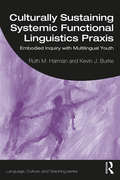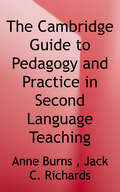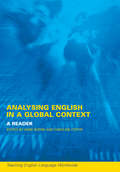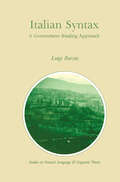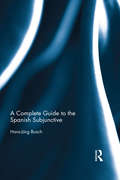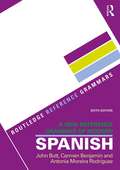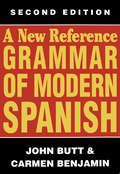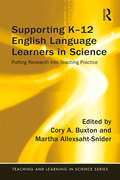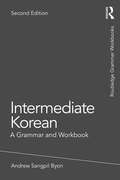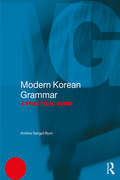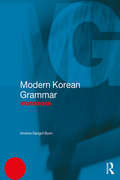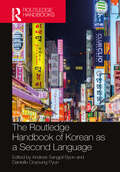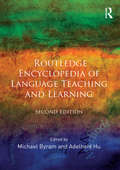- Table View
- List View
Culturally Sustaining Systemic Functional Linguistics Praxis: Embodied Inquiry with Multilingual Youth (Language, Culture, and Teaching Series)
by Kevin J. Burke Ruth M. HarmanBy introducing a framework for culturally sustaining Systemic Functional Linguistics (SFL) praxis, Harman, Burke and other contributing authors guide readers through a practical and analytic exploration of youth participatory work in classroom and community settings. Applying an SFL lens to critical literacy and schooling, this book articulates a vision for youth learning and civic engagement that focuses on the power of performance, spatial learning, community activism and student agency. The book offers a range of research-driven, multimodal resources and methods for teachers to encourage students’ meaning-making. The authors share how teachers and community activists can interact and support diverse and multilingual youth, fostering a dynamic environment that deepens inquiry of the arts and disciplinary area of knowledge. Research in this book provides a model for collaborative engagement and community partnerships, featuring the voices of students and teachers to highlight the importance of agency and action research in supporting literacy learning and transformative inquiry. Demonstrating theoretically and practically how SFL praxis can be applied broadly and deeply in the field, this book is suitable for preservice teachers, teacher educators, graduate students and scholars in bilingual and multilingual education, literacy education and language policy.
The Cambridge Guide To Pedagogy And Practice In Second Language Teaching (PDF)
by Anne BurnsThis collection of original articles provides a state-of-the-art overview of key issues and approaches in contemporary language teaching. Written by internationally prominent researchers, educators, and emerging scholars, the chapters are grouped into five sections: rethinking our understanding of teaching, learner diversity and classroom learning, pedagogical approaches and practices, components of the curriculum, and media and materials. Each chapter covers key topics in teaching methodology such as reflective pedagogy, teaching large classes, outcomes-based language learning, speaking instruction, and technology in the classroom. Chapters assume no particular background knowledge and are written in an accessible style.
Analysing English In A Global Context
by Anne Burns Caroline CoffinDevised in collaboration with the Open University and Macquarie University, Australia, this book is specifically designed for the postgraduate student market, as well as for teachers of English as a second or foreign language throughout the world. It includes specially commissioned pieces as well as classic texts and provides a global perspective on the changing uses and forms of English and its impact on language teaching contexts.
Analysing English In A Global Context (PDF)
by Anne Burns Caroline CoffinDevised in collaboration with the Open University and Macquarie University, Australia, this book is specifically designed for the postgraduate student market, as well as for teachers of English as a second or foreign language throughout the world. It includes specially commissioned pieces as well as classic texts and provides a global perspective on the changing uses and forms of English and its impact on language teaching contexts.
Italian Syntax: A Government-Binding Approach (Studies in Natural Language and Linguistic Theory #1)
by L. BurzioIn the course of our everyday lives, we generally take our knowledge of language for granted. Occasionally, we may become aware of its great practical importance, but we rarely pay any attention to the formal properties that language has. Yet these properties are remarkably complex. So complex that the question immediately arises as to how we could know so much. The facts that will be considered in this book should serve well to illustrate this point. We will see for example that verbs like arrivare 'arrive' and others like telefonare 'telephone', which are superficially similar, actually differ in a large number of respects, some fairly well known, others not. Why should there be such differencces. we may ask. And why should it be that if a verb behaves like arrivare and unlike tetefonare in one respect. it will do so in all others consistently, and how could everyone know it? To take another case, Italian has two series of pronouns: stressed and unstressed. Thus, for example, alongside of reflexive se stesso 'himself which is the stressed form. one finds si which is unstressed but otherwise synonymous. Yet we will see that the differences between the two could not simply be stress versus lack of stress, as their behavior is radically different under a variety of syntactic conditions.
The Spanish Subjunctive: A Reference for Teachers
by Hans-Jorg BuschA Complete Guide to the Spanish Subjunctive is the most complete reference guide to the use of the subjunctive in Spanish. Along with an exhaustive review of published literature on the subjunctive, the book also includes a thorough discussion of the uses and meanings of the subjunctive as well as examples throughout drawn from linguistic corpora such as the CREA database. The book presents a comprehensive theory of the subjunctive and provides practical rules for understanding, teaching and acquiring the Spanish subjunctive. This book includes: "Your Turn" sections that invite readers to reflect on the content discussed and on their own experiences in teaching the subjunctive A "Synopsis" section that summarizes the content of the work and offers practical suggestions for teaching the subjunctive Two indexes providing a summary of verb conjugation in the subjunctive and an alphabetical list of expressions used with the subjunctive.
The Spanish Subjunctive: A Reference for Teachers
by Hans-Jorg BuschA Complete Guide to the Spanish Subjunctive is the most complete reference guide to the use of the subjunctive in Spanish. Along with an exhaustive review of published literature on the subjunctive, the book also includes a thorough discussion of the uses and meanings of the subjunctive as well as examples throughout drawn from linguistic corpora such as the CREA database. The book presents a comprehensive theory of the subjunctive and provides practical rules for understanding, teaching and acquiring the Spanish subjunctive. This book includes: "Your Turn" sections that invite readers to reflect on the content discussed and on their own experiences in teaching the subjunctive A "Synopsis" section that summarizes the content of the work and offers practical suggestions for teaching the subjunctive Two indexes providing a summary of verb conjugation in the subjunctive and an alphabetical list of expressions used with the subjunctive.
A New Reference Grammar of Modern Spanish
by John B. Butt Carmen Benjamin Moreira-Rodriguez AntoniaA New Reference Grammar of Modern Spanish is a comprehensive, cohesive and clear guide to the forms and structures of Spanish as it is written and spoken today in Spain and Latin-America. It includes clear descriptions of all the main grammatical phenomena of Spanish, and their use, illustrated by numerous examples of contemporary Spanish, both Peninsular and Latin-American, formal and informal. Fully revised and updated, the sixth edition is even more relevant to students and teachers of Spanish. The sixth edition includes: • new chapters, providing more detail and examples of key areas of Spanish grammar; • an increased number of Mexican examples to reflect the growing interest in this country’s variety of Spanish; • new information for readers studying Spanish and French together; • a glossary of grammatical terms including English translations of Spanish terms. The combination of reference grammar and manual of current usage is invaluable for learners at level B2–C2 of the Common European Framework for Languages, and Intermediate High–Advanced High on the ACTFL proficiency scales.
A New Reference Grammar of Modern Spanish (Routledge Reference Grammars Ser.)
by John B. Butt Carmen Benjamin Moreira-Rodriguez AntoniaA New Reference Grammar of Modern Spanish is a comprehensive, cohesive and clear guide to the forms and structures of Spanish as it is written and spoken today in Spain and Latin-America. It includes clear descriptions of all the main grammatical phenomena of Spanish, and their use, illustrated by numerous examples of contemporary Spanish, both Peninsular and Latin-American, formal and informal. Fully revised and updated, the sixth edition is even more relevant to students and teachers of Spanish. The sixth edition includes: • new chapters, providing more detail and examples of key areas of Spanish grammar; • an increased number of Mexican examples to reflect the growing interest in this country’s variety of Spanish; • new information for readers studying Spanish and French together; • a glossary of grammatical terms including English translations of Spanish terms. The combination of reference grammar and manual of current usage is invaluable for learners at level B2–C2 of the Common European Framework for Languages, and Intermediate High–Advanced High on the ACTFL proficiency scales.
A New Reference Grammar of Modern Spanish
by John Butt Carmen Benjamin(abridged and revised) This reference grammar offers intermediate and advanced students a reason ably comprehensive guide to the morphology and syntax of educated speech and plain prose in Spain and Latin America at the end of the twentieth century. Spanish is the main, usually the sole official language of twenty-one countries,} and it is set fair to overtake English by the year 2000 in numbers 2 of native speakers. This vast geographical and political diversity ensures that Spanish is a good deal less unified than French, German or even English, the latter more or less internationally standardized according to either American or British norms. Until the 1960s, the criteria of internationally correct Spanish were dictated by the Real Academia Espanola, but the prestige of this institution has now sunk so low that its most solemn decrees are hardly taken seriously - witness the fate of the spelling reforms listed in the Nuevas normas de prosodia y ortograjia, which were supposed to come into force in all Spanish-speaking countries in 1959 and, nearly forty years later, are still selectively ignored by publishers and literate persons everywhere. The fact is that in Spanish 'correctness' is nowadays decided, as it is in all living languages, by the consensus of native speakers; but consensus about linguistic usage is obviously difficult to achieve between more than twenty independent, widely scattered and sometimes mutually hostile countries. Peninsular Spanish is itself in flux.
Doing language im Deutschunterricht: Eine Analyse sprachbezogener Adressierungen in diskursiver Praxis
by Denise BüttnerDie Studie leistet einen empirisch-rekonstruktiven Beitrag zu einer machtkritisch ausgerichteten Fachdidaktik. Sie fokussiert den Deutschunterricht und die darin stattfindenden Interaktionen als diskursive Praxis, in der ein spezifisches Wissen in, über und angesichts von Sprache relevant gemacht wird. Für Subjektivierung ist jenes Wissen hochgradig wirkmächtig und bleibt den Akteur*innen im Prozess der schulischen Enkulturation doch größtenteils unbewusst. Darin liegt ein hohes Potential für die institutionelle (Re-)Produktion von Linguizismus.Vor diesem Hintergrund eröffnet die Studie einen Blick auf sprachbezogene Adressierungen, die in charakteristischer Weise vom Fach selbst ausgehen. Sie werden in (fach)didaktischen und pädagogischen Programmatiken breit kommuniziert und zeichnen sich bis auf die Ebene unterrichtlicher Praktiken ab. Um das Zusammenspiel von fachspezifischer Adressierung und Praktiken des ‚doing language‘ möglichst eng aufeinander beziehen und in rekonstruktionslogisch plausibilisierte Zusammenhänge bringen zu können, liegt der Arbeit ein wissenssoziologisch-diskursanalytischer Ansatz zugrunde.
Supporting K-12 English Language Learners in Science: Putting Research into Teaching Practice (Teaching and Learning in Science Series)
by Cory Buxton Martha Allexsaht-SniderThe contribution of this book is to synthesize important common themes and highlight the unique features, findings, and lessons learned from three systematic, ongoing research and professional learning projects for supporting English learners in science. Each project, based in a different region of the U.S. and focused on different age ranges and target populations, actively grapples with the linguistic implications of the three-dimensional learning required by the Framework for K-12 Science Education and the Next Generation Science Standards. Each chapter provides research-based recommendations for improving the teaching of science to English learners. Offering insights into teacher professional learning as well as strategies for measuring and monitoring how well English learners are learning science and language, this book tells a compelling and inclusive story of the challenges and the opportunities of teaching science to English learners.
Supporting K-12 English Language Learners in Science: Putting Research into Teaching Practice (Teaching and Learning in Science Series)
by Cory Buxton Martha Allexsaht-SniderThe contribution of this book is to synthesize important common themes and highlight the unique features, findings, and lessons learned from three systematic, ongoing research and professional learning projects for supporting English learners in science. Each project, based in a different region of the U.S. and focused on different age ranges and target populations, actively grapples with the linguistic implications of the three-dimensional learning required by the Framework for K-12 Science Education and the Next Generation Science Standards. Each chapter provides research-based recommendations for improving the teaching of science to English learners. Offering insights into teacher professional learning as well as strategies for measuring and monitoring how well English learners are learning science and language, this book tells a compelling and inclusive story of the challenges and the opportunities of teaching science to English learners.
Intermediate Korean: A Grammar and Workbook (Grammar Workbooks)
by Andrew Sangpil ByonIntermediate Korean: A Grammar and Workbook comprises an accessible reference grammar and related exercises in a single volume. This workbook presents twenty-four individual grammar points, covering the core material which students would expect to encounter in their second year of learning Korean. Grammar points are followed by examples and exercises which allow students to reinforce and consolidate their learning. Intermediate Korean is suitable for both class use as well as independent study. Key features include: clear, accessible format many useful language examples all Korean entries presented in Hangul with English translations jargon-free explanations of grammar abundant exercises with full answer key subject index. Clearly presented and user-friendly, Intermediate Korean provides readers with the essential tools to express themselves in a wide variety of situations, making it an ideal grammar reference and practice resource for students with some knowledge of the language.
Intermediate Korean: A Grammar and Workbook (Grammar Workbooks)
by Andrew Sangpil ByonIntermediate Korean: A Grammar and Workbook comprises an accessible reference grammar and related exercises in a single volume. This workbook presents twenty-four individual grammar points, covering the core material which students would expect to encounter in their second year of learning Korean. Grammar points are followed by examples and exercises which allow students to reinforce and consolidate their learning. Intermediate Korean is suitable for both class use as well as independent study. Key features include: clear, accessible format many useful language examples all Korean entries presented in Hangul with English translations jargon-free explanations of grammar abundant exercises with full answer key subject index. Clearly presented and user-friendly, Intermediate Korean provides readers with the essential tools to express themselves in a wide variety of situations, making it an ideal grammar reference and practice resource for students with some knowledge of the language.
Intermediate Korean: A Grammar and Workbook (Routledge Grammar Workbooks)
by Andrew Sangpil ByonThis revised second edition of Intermediate Korean: A Grammar and Workbook is an accessible reference grammar and related exercises in a single volume. The text can be used in conjunction with any primary textbook, both as a reference guide to the intermediate Korean grammar and a practice book to reinforce learning. This book presents 24 individual grammar points, covering the core material that students would expect to encounter in their second year of learning Korean. Grammar points are followed by examples and exercises which allow students to reinforce and consolidate their learning. Key features include: Clear, accessible format Many useful language examples All Korean entries presented in Hangul with English translations Abundant exercises with full answer key Subject index. Clearly presented and user-friendly, Intermediate Korean provides readers with the essential tools to express themselves in a wide variety of situations, making it an ideal grammar reference and practice resource for students with some knowledge of the language. Intermediate Korean is suitable for both class use as well as independent study.
Intermediate Korean: A Grammar and Workbook (Routledge Grammar Workbooks)
by Andrew Sangpil ByonThis revised second edition of Intermediate Korean: A Grammar and Workbook is an accessible reference grammar and related exercises in a single volume. The text can be used in conjunction with any primary textbook, both as a reference guide to the intermediate Korean grammar and a practice book to reinforce learning. This book presents 24 individual grammar points, covering the core material that students would expect to encounter in their second year of learning Korean. Grammar points are followed by examples and exercises which allow students to reinforce and consolidate their learning. Key features include: Clear, accessible format Many useful language examples All Korean entries presented in Hangul with English translations Abundant exercises with full answer key Subject index. Clearly presented and user-friendly, Intermediate Korean provides readers with the essential tools to express themselves in a wide variety of situations, making it an ideal grammar reference and practice resource for students with some knowledge of the language. Intermediate Korean is suitable for both class use as well as independent study.
Modern Korean Grammar: A Practical Guide (Modern Grammars)
by Andrew Sangpil ByonRoutledge’s Modern Grammar series is an innovative reference guide combining traditional and function-focused grammar in a single volume, with an accompanying workbook. The aim of the Modern Korean Grammar is to provide an overview of the structures and functions of the Korean language. Designed for those who have already acquired the basics of the language, the book combines a comprehensive description of the grammatical structures of Korean with a functional/usage approach to the language. All target grammatical and functional points will be illustrated with examples in Hangul with English translations for better understanding. In addition, the use of linguistic terminology is limited, to facilitate quick and easy comprehension.
Modern Korean Grammar: A Practical Guide (Modern Grammars)
by Andrew Sangpil ByonRoutledge’s Modern Grammar series is an innovative reference guide combining traditional and function-focused grammar in a single volume, with an accompanying workbook. The aim of the Modern Korean Grammar is to provide an overview of the structures and functions of the Korean language. Designed for those who have already acquired the basics of the language, the book combines a comprehensive description of the grammatical structures of Korean with a functional/usage approach to the language. All target grammatical and functional points will be illustrated with examples in Hangul with English translations for better understanding. In addition, the use of linguistic terminology is limited, to facilitate quick and easy comprehension.
Modern Korean Grammar Workbook
by Andrew Sangpil ByonRoutledge’s Modern Grammar series is an innovative reference guide combining traditional and function-focused grammar in a single volume, with an accompanying workbook.The aim of the Modern Korean Grammar Workbook is to strengthen the reader’s understanding of the main volume, Modern Korean Grammar.. Designed for those who have already acquired the basics of the language, this workbook provides abundant innovative exercises for both essential grammatical features and everyday usage and functions (e.g., giving advices, greetings, requesting, etc.). The Modern Korean Grammar Workbook is an ideal practice tool for Korean-as a foreign/second (KFL) learners. No prior knowledge of grammatical terminology is assumed and it can be used both independently and alongside Modern Korean Grammar.
Modern Korean Grammar Workbook
by Andrew Sangpil ByonRoutledge’s Modern Grammar series is an innovative reference guide combining traditional and function-focused grammar in a single volume, with an accompanying workbook.The aim of the Modern Korean Grammar Workbook is to strengthen the reader’s understanding of the main volume, Modern Korean Grammar.. Designed for those who have already acquired the basics of the language, this workbook provides abundant innovative exercises for both essential grammatical features and everyday usage and functions (e.g., giving advices, greetings, requesting, etc.). The Modern Korean Grammar Workbook is an ideal practice tool for Korean-as a foreign/second (KFL) learners. No prior knowledge of grammatical terminology is assumed and it can be used both independently and alongside Modern Korean Grammar.
The Routledge Handbook of Korean as a Second Language
by Andrew Sangpil Byon Danielle Ooyoung PyunThe Routledge Handbook of Korean as a Second Language aims to define the field and to present the latest research in Korean as a second language (KSL). It comprises a detailed overview of the field of KSL teaching and learning, discusses its development, and captures critical cutting-edge research within its major subfields. As the first handbook of KSL published in English, this book will be of particular interest to advanced undergraduates, graduate students, language teachers, curriculum developers, and researchers in the fields of KSL and applied linguistics. While each chapter will be authored by internationally renowned scholars in its major subfields, the handbook aims to maintain accessibility so that it can also be of value to non-specialists.
The Routledge Handbook of Korean as a Second Language
by Andrew Sangpil Byon Danielle Ooyoung PyunThe Routledge Handbook of Korean as a Second Language aims to define the field and to present the latest research in Korean as a second language (KSL). It comprises a detailed overview of the field of KSL teaching and learning, discusses its development, and captures critical cutting-edge research within its major subfields. As the first handbook of KSL published in English, this book will be of particular interest to advanced undergraduates, graduate students, language teachers, curriculum developers, and researchers in the fields of KSL and applied linguistics. While each chapter will be authored by internationally renowned scholars in its major subfields, the handbook aims to maintain accessibility so that it can also be of value to non-specialists.
Routledge Encyclopedia of Language Teaching and Learning
by Michael Byram Adelheid HuThe Routledge Encyclopedia of Language Teaching and Learning is an authoritative reference dealing with all aspects of this increasingly important field of study. Offering a comprehensive range of articles on contemporary language teaching and its history, it has been produced specifically for language teaching professionals and as a reference work for academic studies at postgraduate level. In this new edition, every single entry has been reviewed and updated with reference to new developments and publications. Coverage has been expanded to reflect new technological, global and academic developments, with particular attention to areas such as online and distance learning, teacher and learner cognition, testing, assessment and evaluation, global English and teacher education. Themes and disciplines covered include: Methods and materials, including new technologies and materials development Contexts and concepts, such as mediation, risk-taking in language learning and intercomprehension Influential figures from the early days of language teaching to the contemporary Related disciplines, such as psychology, anthropology and corpus linguistics It covers the teaching of specific languages, including Japanese, Chinese, Arabic and African languages, as well as English, French, German and Spanish. There are thirty five overview articles dealing with issues such as communicative language teaching, early language learning, teacher education and syllabus and curriculum design. A further 160 entries focus on topics such as bilingualism, language laboratories and study abroad. Numerous shorter items examine language and cultural institutions, professional associations and acronyms. Multiple cross-references enable the user to browse from one entry to another, and there are suggestions for further reading. Written by an international team of specialists, the Routledge Encyclopedia of Language Teaching and Learning is an invaluable resource and reference manual for anyone with a professional or academic interest in the subject.
Routledge Encyclopedia of Language Teaching and Learning
by Michael Byram Adelheid HuThe Routledge Encyclopedia of Language Teaching and Learning is an authoritative reference dealing with all aspects of this increasingly important field of study. Offering a comprehensive range of articles on contemporary language teaching and its history, it has been produced specifically for language teaching professionals and as a reference work for academic studies at postgraduate level. In this new edition, every single entry has been reviewed and updated with reference to new developments and publications. Coverage has been expanded to reflect new technological, global and academic developments, with particular attention to areas such as online and distance learning, teacher and learner cognition, testing, assessment and evaluation, global English and teacher education. Themes and disciplines covered include: Methods and materials, including new technologies and materials development Contexts and concepts, such as mediation, risk-taking in language learning and intercomprehension Influential figures from the early days of language teaching to the contemporary Related disciplines, such as psychology, anthropology and corpus linguistics It covers the teaching of specific languages, including Japanese, Chinese, Arabic and African languages, as well as English, French, German and Spanish. There are thirty five overview articles dealing with issues such as communicative language teaching, early language learning, teacher education and syllabus and curriculum design. A further 160 entries focus on topics such as bilingualism, language laboratories and study abroad. Numerous shorter items examine language and cultural institutions, professional associations and acronyms. Multiple cross-references enable the user to browse from one entry to another, and there are suggestions for further reading. Written by an international team of specialists, the Routledge Encyclopedia of Language Teaching and Learning is an invaluable resource and reference manual for anyone with a professional or academic interest in the subject.
